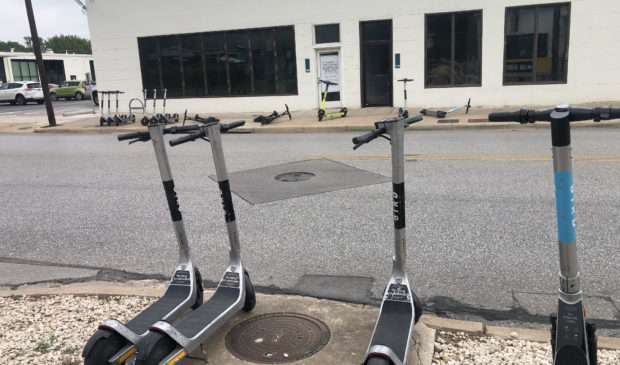Trash and scooters still clogging Austin creeks, study finds
Tuesday, August 23, 2022 by
Chad Swiatecki The city’s attempts to keep garbage out of local creeks are still being stymied by discarded motorized scooters, according to the findings of a roughly six-month analysis of 20 watersheds throughout Austin.
A memo released last week presented the findings of the Trash in Creeks field study that was completed this spring and gathered 19,467 data points along 110 miles of local streams, gauging the intensity and location of trash in waterways. The analysis was one of the deliverables called for in a 2020 City Council resolution that targeted the growing problem of waste, including scooters heavy with batteries and other electronics, accumulating in creeks.
The Watershed Protection Department removed 21 scooters from creeks over the course of the field study, with a number of strategies underway or recommended to reduce the incidence of those devices being abandoned near bodies of water. The steps include special signage installed by the Austin Transportation Department as well as geofencing to prohibit micromobility devices from being parked on bridges; modifying the 311 mobile app so scooter companies can be contacted directly to retrieve abandoned devices; updating the rules governing dockless transportation to include language protecting watersheds; and maintaining the current cap of 8,100 total micromobility devices allowed in downtown Austin.
When Council passed the resolution in 2020, the popularity of motorized scooters was adding a problematic and dangerous dimension to the problem of trash in local creeks.
Council Member Leslie Pool voiced support for fining scooter companies for every scooter that city crews or contractors had to retrieve, with those fines helping to cover some of the costs associated with general trash removal from watersheds.
“The scooters are clearly being tossed into our waterways and are absolutely polluting, and we’ve had these discussions for more than a year now,” she said. “The pollutants that are being introduced as a result of the scooters and other electronics, I agree we need to have a way to have the cost burden sharing with the companies that have introduced the scooters and other electronic vehicles into our city.”
Council Member Paige Ellis said at the time of the adoption that the city would have a plan and funding in place within a year to address the general problem of waste, including scooters, with drainage utility fees or the Clean Community fee as possible funding sources. The onset of the Covid-19 pandemic a few months after the resolution’s passage delayed the start of the field analysis until late 2021.
“Given the environmental hazard nature of what happens when scooters end up in our creeks, it’s not good for our creeks, not good for our scooter companies or trying to have affordable mobility options,” she said. “I wanted to make sure we weren’t waiting one year for the survey and another year for the budget while we have rechargeable batteries hanging out in Town Lake.”
The study produced plenty of data around the accumulation of other trash in local waterways, but didn’t choose specific methods to collect refuse or reduce the occurrence of dumping. It found that three-quarters of total trash volume – mostly food and beverage containers – in local waterways are contained in roughly 11 miles of the 110 total miles examined. Those findings suggest the amount of trash in creeks is influenced mostly by how rapidly the creek moves.
An accompanying examination of waste collection and prevention methods used by cities throughout the country and around the globe offered a variety of options for consideration, though the large variance in costs, effectiveness and local characteristics obscured any clear choices.
The memo does note that “the scale and scope of this problem will require increased staff and contractual resources if we as a community want to prioritize reductions of trash in our watersheds and waterways.”
The Austin Monitor’s work is made possible by donations from the community. Though our reporting covers donors from time to time, we are careful to keep business and editorial efforts separate while maintaining transparency. A complete list of donors is available here, and our code of ethics is explained here.
You're a community leader
And we’re honored you look to us for serious, in-depth news. You know a strong community needs local and dedicated watchdog reporting. We’re here for you and that won’t change. Now will you take the powerful next step and support our nonprofit news organization?



